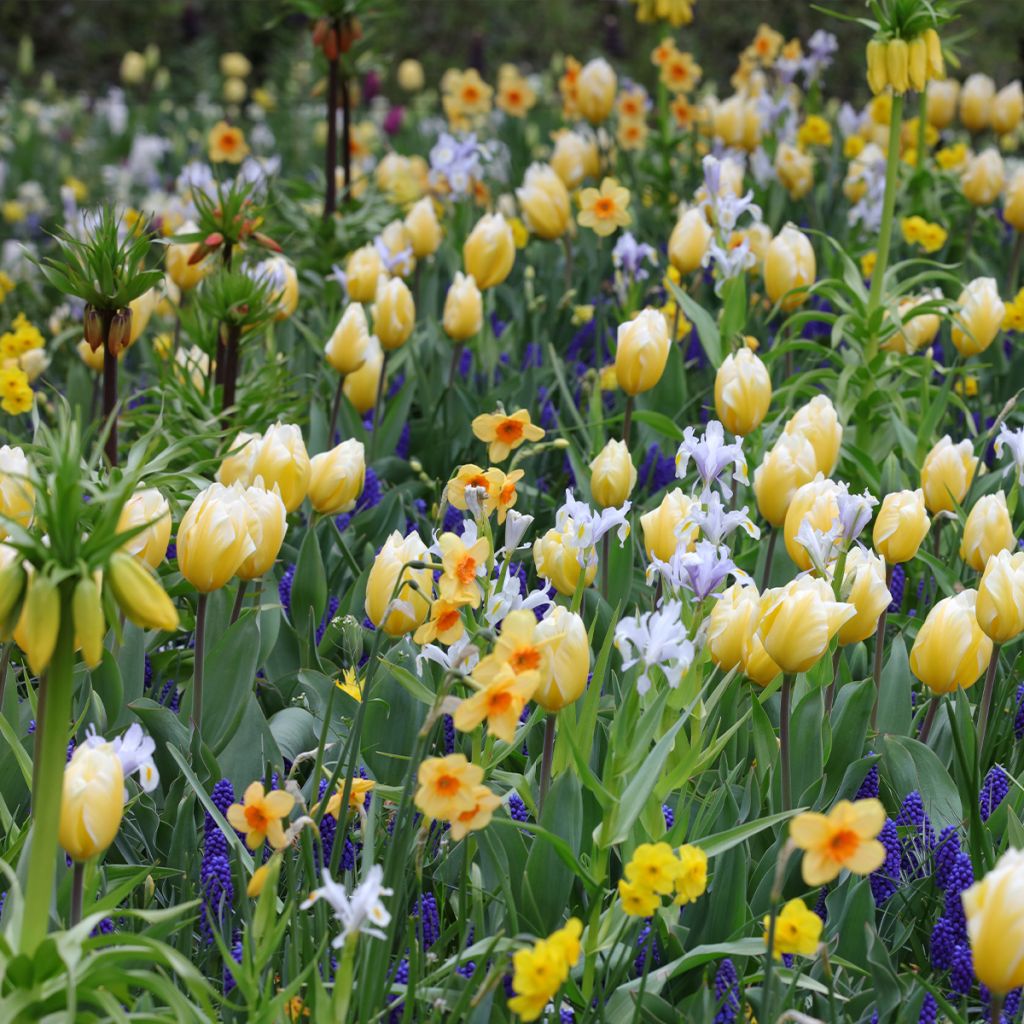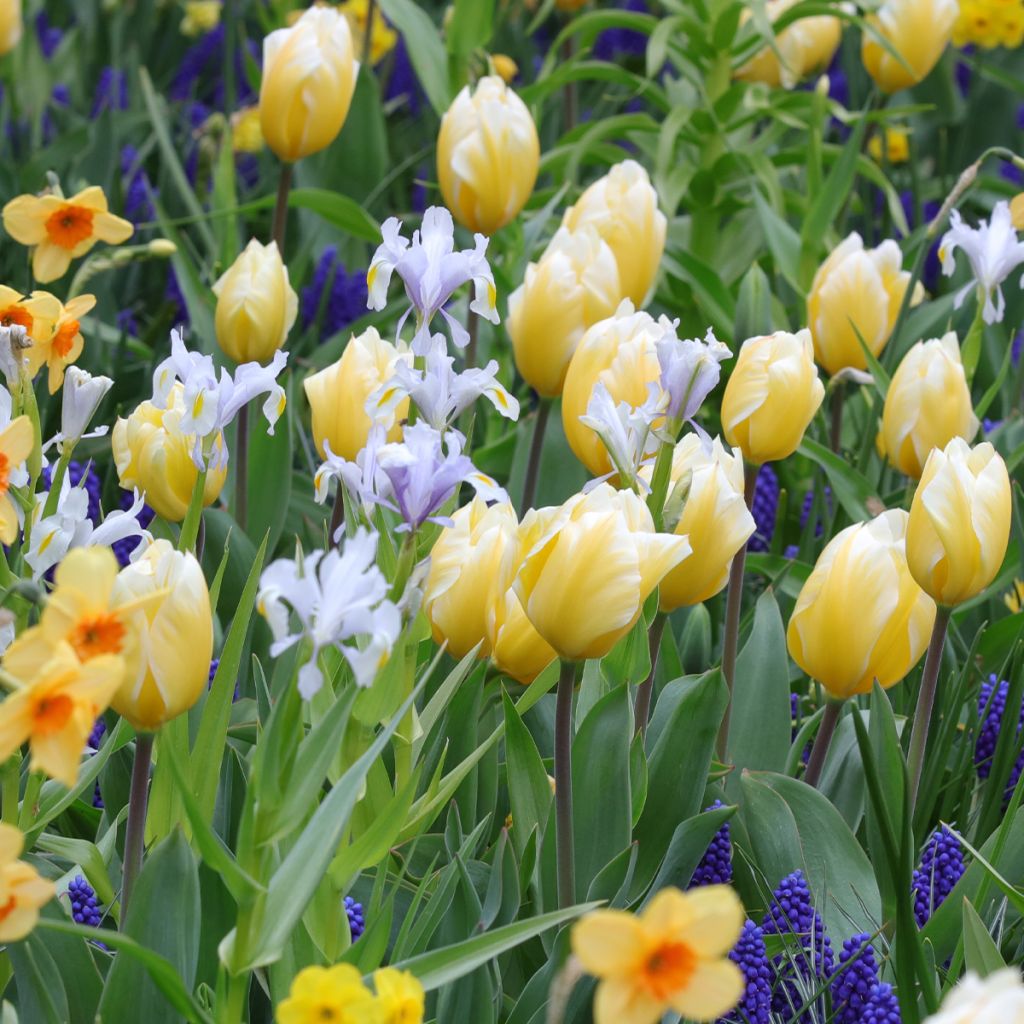

Collection Harmonie contrastée


Collection Harmonie contrastée
Contrasting Harmony Collection
Tulipa, Narcissus, Muscari, Iris
At the moment, the daffodils and the grape hyacinths are the only ones that have bloomed. So I don't know if they will all bloom at the same time, but it already looks beautiful and I can see the first bumblebees buzzing around.
Anne-Marie T., 23/03/2023
This plant carries a 6 months recovery warranty
More information
We guarantee the quality of our plants for a full growing cycle, and will replace at our expense any plant that fails to recover under normal climatic and planting conditions.
From €5.90 for pickup delivery and €6.90 for home delivery
Express home delivery from €8.90.
Does this plant fit my garden?
Set up your Plantfit profile →
Collection items (52 plants)
Description
A collection that brilliantly showcases the contrast and harmony by playing with the complementary colours and shapes of flowers. Not forgetting the fragrance. The tulip and the narcissus, both in shades of yellow, collide with the vivid violet-blue of the muscari, while the porcelain flower of the iris, washed in white with a touch of mauve and enhanced with gold, harmonises the whole. All these blooming bulbs create a joyful scene that heralds the return of spring. Add height and style to your flower bed by interplanting with imperial fritillaries!
The Harmonious Contrast collection consists of:
- 10x Tulipa fosteriana Sweetheart: a rather old variety with large, bright, single flowers, narrow, irregularly edged with cream-white to ivory. Very resistant, robust, and undemanding, it will faithfully return for many years without degenerating. It is also one of the first to bloom, as early as late March. Its stems, 35-40 cm (14-16in) tall, are very strong.
- 10x Narcissus jonquilla Martinette: a multi-flowered jonquil narcissus with small, fragrant yellow and orange flowers. Similar to the true jonquil of Southern Europe, it produces several flowers on each stem. This variety thrives in warm and dry climates in summer, where it naturalises easily, in full sun or under trees. Blooms in March on stems of 40-45 cm (16-18in).
- 30x Muscari armeniacum: perfectly hardy in all our regions, this muscari multiplies spontaneously and rapidly. Its small, vivid violet-blue flower spikes exude a sweet fragrance. The plant does not exceed 15 to 20 cm (6 to 8in) in height. Blooms in March-April, depending on the climate.
- 2x Iris magnifica: also known as Juno magnifica, this bulbous iris is decorative with its foliage resembling that of corn and its delicate flowers. They are composed of white sepals with pale blue-mauve tips, adorned with a golden spot, topped with almost white petals. It can reach a height of 30 to 60 cm (12 to 24in), and the flowering can last up to 5 weeks, in April-May.
Individually labelled.
This collection finds its place in large flower beds, borders, rock gardens, and flower borders. Composed of hardy and faithful bulbous plants, it will settle for many years and bloom happily every spring. It can also be used in pots or containers, decorating balconies and terraces. It will also be ideal for creating elegant bouquets. Beware, the stems of Narcissi contain a substance that quickly wilts other flowers. This detrimental effect can be mitigated by dipping the ends of the narcissus stems in hot water for 1 to 2 minutes. Additionally, if your tulips open too quickly, you can add two to three ice cubes to the vase every day. Only use very little water, just a bottom is enough!
Report an error about the product description
Plant habit
Flowering
Foliage
Botanical data
Tulipa, Narcissus, Muscari, Iris
Cultivar or hybrid
Planting and care
Plant your bulbs as soon as possible in a well-drained and light soil. Loosen the soil deeply. Plant at a depth of 10 cm (4in) (Bulbs should be covered with twice their height of soil). Space the bulbs a few cm apart, making sure they don't touch. Choose a sunny exposure for better flowering. After flowering, cut the flower stalks and let the leaves dry completely before cutting them.
Planting period
Intended location
Care
-
, onOrder confirmed
Reply from on Promesse de fleurs
Haven't found what you were looking for?
Hardiness is the lowest winter temperature a plant can endure without suffering serious damage or even dying. However, hardiness is affected by location (a sheltered area, such as a patio), protection (winter cover) and soil type (hardiness is improved by well-drained soil).

Photo Sharing Terms & Conditions
In order to encourage gardeners to interact and share their experiences, Promesse de fleurs offers various media enabling content to be uploaded onto its Site - in particular via the ‘Photo sharing’ module.
The User agrees to refrain from:
- Posting any content that is illegal, prejudicial, insulting, racist, inciteful to hatred, revisionist, contrary to public decency, that infringes on privacy or on the privacy rights of third parties, in particular the publicity rights of persons and goods, intellectual property rights, or the right to privacy.
- Submitting content on behalf of a third party;
- Impersonate the identity of a third party and/or publish any personal information about a third party;
In general, the User undertakes to refrain from any unethical behaviour.
All Content (in particular text, comments, files, images, photos, videos, creative works, etc.), which may be subject to property or intellectual property rights, image or other private rights, shall remain the property of the User, subject to the limited rights granted by the terms of the licence granted by Promesse de fleurs as stated below. Users are at liberty to publish or not to publish such Content on the Site, notably via the ‘Photo Sharing’ facility, and accept that this Content shall be made public and freely accessible, notably on the Internet.
Users further acknowledge, undertake to have ,and guarantee that they hold all necessary rights and permissions to publish such material on the Site, in particular with regard to the legislation in force pertaining to any privacy, property, intellectual property, image, or contractual rights, or rights of any other nature. By publishing such Content on the Site, Users acknowledge accepting full liability as publishers of the Content within the meaning of the law, and grant Promesse de fleurs, free of charge, an inclusive, worldwide licence for the said Content for the entire duration of its publication, including all reproduction, representation, up/downloading, displaying, performing, transmission, and storage rights.
Users also grant permission for their name to be linked to the Content and accept that this link may not always be made available.
By engaging in posting material, Users consent to their Content becoming automatically accessible on the Internet, in particular on other sites and/or blogs and/or web pages of the Promesse de fleurs site, including in particular social pages and the Promesse de fleurs catalogue.
Users may secure the removal of entrusted content free of charge by issuing a simple request via our contact form.
The flowering period indicated on our website applies to countries and regions located in USDA zone 8 (France, the United Kingdom, Ireland, the Netherlands, etc.)
It will vary according to where you live:
- In zones 9 to 10 (Italy, Spain, Greece, etc.), flowering will occur about 2 to 4 weeks earlier.
- In zones 6 to 7 (Germany, Poland, Slovenia, and lower mountainous regions), flowering will be delayed by 2 to 3 weeks.
- In zone 5 (Central Europe, Scandinavia), blooming will be delayed by 3 to 5 weeks.
In temperate climates, pruning of spring-flowering shrubs (forsythia, spireas, etc.) should be done just after flowering.
Pruning of summer-flowering shrubs (Indian Lilac, Perovskia, etc.) can be done in winter or spring.
In cold regions as well as with frost-sensitive plants, avoid pruning too early when severe frosts may still occur.
The planting period indicated on our website applies to countries and regions located in USDA zone 8 (France, United Kingdom, Ireland, Netherlands).
It will vary according to where you live:
- In Mediterranean zones (Marseille, Madrid, Milan, etc.), autumn and winter are the best planting periods.
- In continental zones (Strasbourg, Munich, Vienna, etc.), delay planting by 2 to 3 weeks in spring and bring it forward by 2 to 4 weeks in autumn.
- In mountainous regions (the Alps, Pyrenees, Carpathians, etc.), it is best to plant in late spring (May-June) or late summer (August-September).
The harvesting period indicated on our website applies to countries and regions in USDA zone 8 (France, England, Ireland, the Netherlands).
In colder areas (Scandinavia, Poland, Austria...) fruit and vegetable harvests are likely to be delayed by 3-4 weeks.
In warmer areas (Italy, Spain, Greece, etc.), harvesting will probably take place earlier, depending on weather conditions.
The sowing periods indicated on our website apply to countries and regions within USDA Zone 8 (France, UK, Ireland, Netherlands).
In colder areas (Scandinavia, Poland, Austria...), delay any outdoor sowing by 3-4 weeks, or sow under glass.
In warmer climes (Italy, Spain, Greece, etc.), bring outdoor sowing forward by a few weeks.






































